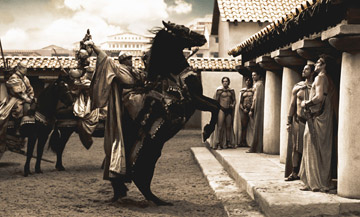
Last night I went to the midnight premiere of 300. I had been looking forward to this for quite a while, as I really enjoy Frank Miller’s work and, quite frankly, loved the way Zack Snyder visually reinterpreted Romero’s classic Dawn of the Dead. These two elements combined should be good, I thought.
I was not disappointed. Visually the film is absolutely stunning and unlike anything I have ever seen. Justin: we need to go see this thing in the IMAX. I was aware of the fact that Snyder arranged the film as a frame-by-frame adaptation of Miller’s graphic novel, but I did not expect the amount of dedication to visually representing the original. The entire film truly resembles in its construction more the style of a graphic novel than of a conventional movie, pausing frequently to emphasize still images/shots that in an almost painterly fashion represent the visually most impressive frames from the graphic novel. In this respect the film truly caters primarily to the interests of the fans of the comic book, creating quite frequent applause for its interpretation of famous images from the book.
Here an example:
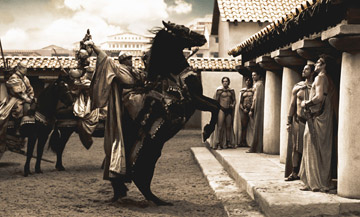
In this shot you will see the camery slowly panning back, the motion slowing down until it finally stops, freezing the shot at the moment of it visual climax, the characters posing as in classical paintings (throughout the entire movie reminiscent of, say, Briullov) having reached the moment at which it perfectly corresponds to the image in the book. These moments in the movie work quite well for me in this genre as it combines beautiful cinematography with Miller’s gritty graphic-novel style of almost violently hammering powerful images into your brain.
Zack Snyder hired comic book artists to in fact draw elements of the movie, such as the (quite generous amount of) blood you see flying about. The cinematography is in part done by the people that also did Sin City, which was another example of one of the few successful filmic engagements with the graphic novel genre. So, as I said, visually the film is nothing less than spectacular–here a few more examples:
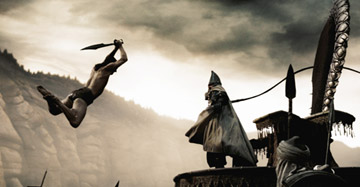
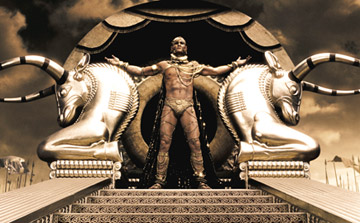

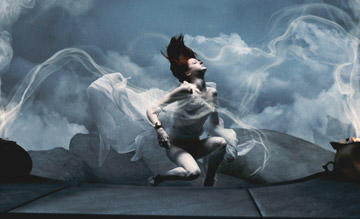
After I have been so explicitly stressing the fact the I was impressed by the movie mainly on a visual level, you have probably been expecting the next part of this post: the characters as well as the way the plot is being presented is absolute shite. More than that, I find it quite problematically un-self-conscious in its engagement with a quite frankly at times inflammatory subject matter. First, however the characters: well, there really are none except for a rather one-dinemsional King Leonidas, a slimy politician and a massive assortment of purely visually interesting characters (if you wanna see a bunch of really good, half-naked male bodies, this may in fact be a good movie for you–in addition to that: masculinity galore! the voices in the crowd–80% male 20-30 year-olds–must have dropped an octave after the movie–the ultra-macho, “we are the toughest and baddest soldiers in the world” crap really seemed to appeal to the glands and crotchal area of this audience–lots of manly grunting and repeating of macho scenes after the movie–I actually observed one guy whose chest had expanded so much with his newfound machismo and willingness to die for freedom that he could not fit through the door of the movie theater any more). So, my point is: lots of people, not many interesting characters: here the film actually managed to be more one-dimensional than the comic book.
Furthermore the whole Greek and Western democracy vs. Persian tyranny. Persians are evil because they are: not democratic, do not respect women, are cowards who do not fight properly, hold slaves, are perverts who pierce their faces and watch loose women belly-dance, wear effeminite jewelry and are imperialists. You can see how this might be a problem. Opposed to this is Greek democracy, masculinity, strength, courage, freedom, respecting women (well, mainly they are respected, since, as the Queen proclaims herself, they are the only women who give birth to real men–not quite what you would call liberated women, thus) etc. To this mix the movie adds phrases such as “freedom is not free,” which leave more than just a bad aftertaste in your mouth regarding current propaganda. In a way the whole movie can be construed as a “support our troops” argument, as if it was the fault of the democratic house and senate and not of the leaders of this country that our troops have insufficient support in a war they should not be in. Be that as it may, the movie does indeed what I suspected it might do (as I mentioned in a earlier post). Sadly, the movie could easily, with just a few small perspective shifts, have been made into a progressive critique of imperialism and into an argument for the need to rescue democracy and freedom by likening the US more to the imperialist power of Xerxes (hence making the Persian empire appear not opposed to, but similar to current US imperialism [“we accept your independence, you just must kneel before us”], deflating the opposition to a historical problem of the evil of imperialism, not as the evil of Persia/Iran) than to the Spartans. As it is the association runs clearly along the lines of Sparta-US vs. Persia-Iran/Middle East–quite sad, given what could have been done with this (i.e. a more nuanced definition of democracy, as Xerxes offers Leonidas the function within a republic, which stands opposed to true democracy–it is precisely this function of nations in a global imperialist republic that could have been so powerfully made into an analogy for US imperial rule).
Alas, this did not happen and so I was left wishing I could just turn of my brain, forget about the political problems the movie was simply too lazy to take into account and enjoy the pictures. Sadly, I do not think anyone can do that and, judging from the behavior of the crowd after the end of the movie, sadly most people seemed to have eaten up the US-Sparta interpretation of the issue that perpetuates the de-historicized and uncritical engagement with the concept of democracy as just as an empty signifier in an ideological machine.
***EDIT: if you would like to save some money, here the basic plot of the entire thing in two short and free trailers–again, as said before, note the use of NIN (may be the best thing about the trailers):
http://youtube.com/watch?v=uhi5x7V3WXE
and the adult-rated, longer version:
http://www.youtube.com/watch?v=28IjXoTP4yg&NR
BTW: note also the anti-Iranian sentiments in the comment section, which also seems to indicate a general inability to distinguish between Persian and Arab.
On a different note, in the second trailer you will also see an image of Snyder’s next project, the film version of Alan Moore’s Watchmen I wrote about a while ago. There are already some pictures of Rorschach roaming the www.
***
7 Comments
Comments RSS TrackBack Identifier URI

Ouch! Did they have lines such as “Freedom is not free” in the novel! Puke!
Have you seen World Trade Center? There is this annoying former marine turned Christian turned marine who is also serving as one big Freedom for America, One man can change it all phrase dropper throughout the movie. Thank God it forgot most of this lines.
I am going to sit down now and have a tête à tête with SRK in Asoka:-)
I actually did not see _World Trade Center_. I meant to, though. I am very interested in how the falling of the towers functions aesthetically as a symbol in relation to globalization.
And about _300_: yes, there was a whole lotta stuff in there that drew rhetorical parallells between the battle of Thermopylae and the war on terror. Most dangerously, of course, is the parallel that might end up suggesting that the war in Iraq was not only justified, but necessary in order to protect the homeland.
Yesterday the trailer for 300 was featured on the youtube homepage – cannot find that version anymore, but the voice over was recorded with a pathetic, American accent – something like “300 men… and a fight for freedom” – those probably weren’t the words, but they conjure up the idea…
Haven’t watched the trailers now, I don’t think that I am going to watch it. The effects look stunning, but I cannot bear the narrative. “Spartans! Tonight we die in hell!” Appears to me like an inverted version of Independence Day “Americans! We will not go quietly into the night! Tonight we celebrate our independence day!”
While the NIN sound track improves the adult rated trailer a lot, it also emphasizes a certain technofascist aesthetic (à la Front 242) that make me feel rather sick, while I can at the same time see why it’s fascinating. Riefenstahl for the CGI generation. Not my cup of tea (I think that I should protect myself against some aesthetics, and this is one of them).
And, lastly, I wish there was an end to this endless series of “righteous fight for freedom” romantizations that the film industry has been cranking out ever since its inception. I no that hope is futile… but strikes me ever the more to see how film narratives are so overtly infected by this discourse, at the very same time that this discourse is being actualized almost farcically in the political arena. Doesn’t everybody see this unbearable parallelism? Apparently not:-)
Of course I meant: HAVING watched the trailers now…
In a recent post about apocalyptic films you made a very good point about their resorting to the nostalgic mode in order to admire and/or critisize past utopias instead of offering any analysis or utopia or anti-utopia for the present. I would elaborate on that and say that their retro-futuristic operation isn’t performed consequentially so as to find a potentiality in the past for our future. (THE LIVES OF OTHERS is especially off-putting this way; it analyzes the socialist surveillance state in Germany with proper insight and precision, only to end up concluding that our present capitalist global state is perfect, i.e. George Soros’s open society) An even better point was their resorting to humanism, which I pointed out myself in several of my own reviews.
I am therefore wondering whether this new aesthetic – like Snyder’s 300 – precisely by this ”hollowing out” of ideological content in favor of a nostalgic fetishization of the surface (the green palette in Children of Men, or the hyperrealistic splendor of 300)… is not a new method of propaganda which suspends the possibility of examining ideology. A related thread on Antigram (antigram.blogspot.com) might be of interest to you.
Do you have any thoughts on this?
Greetings from Dejan
Thanks a lot for this post. You raise interesting questions and I definitely see your point. I would suggest that we need to differentiate between two categories of films here that have two different projects. What I tend to spot in postapocalyptic films is that they are arranged as not just reflections on, but rejections of the present–mostly we have some kind of narrative that criticizes the present for the chaotic tendencies we have introduced into it, tendencies that can seemingly only be fixed by a return to archaic narratives of stability and order. The other group of films, of which I would say _300_ is an example, falls into the kind of nostalgia work you describe that makes the analysis of ideological forces increasingly difficult. One of the ways in which this happens in _300_, for example, is by utilizing the affect produced out of the inreasing disappearance of traditional identity categories–i.e. the narrative of “masculinity under attack” in connection to “national identity and security under attack” is for me centrally involved in the problematic ideological coding you describe.
cheers, M.
tendencies that can seemingly only be fixed by a return to archaic narratives of stability and order.
yes that’s what i meant when i said they start a retro-futuristic movement, but don;’t complete it. instead of finding a potentiality for the future in the past, they get stuck on the past. and then it ends up reactionary. if perhaps you’re following shaviro’s discussions on eastern european film, which mention a number of yugoslav films, i think it will interest you that these old films, lesser known in the west, did not commit the same error (i am talking for example about special treatment by goran paskaljevic) & were subversive despite the fact that their communist conditions of production posed similar ideological challenges as today’s global capitalism
masculinity under attack” in connection to “national identity and security under attack”
this interests me especially. when the empire goes out bombing places like iraq, their propaganda often consists of queer attacks on (patriarchally defined) masculinity – take for example the ALIENS-like tortures by Lieutant Lindy/Sigourney Weaver. While in 300 patriarchal masculinity is associated with homoerotic Sparta, and pitted against queerness. It seems that both queerness and patriarchy are being carried by the same heteronormative structure!!!
This is very insidious.